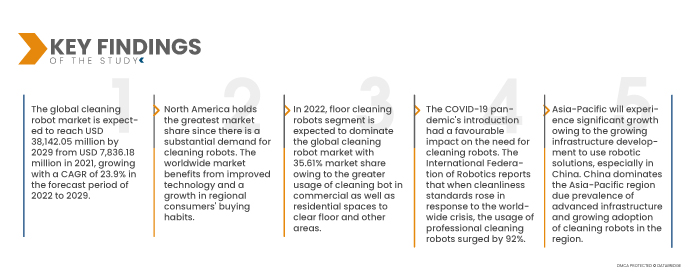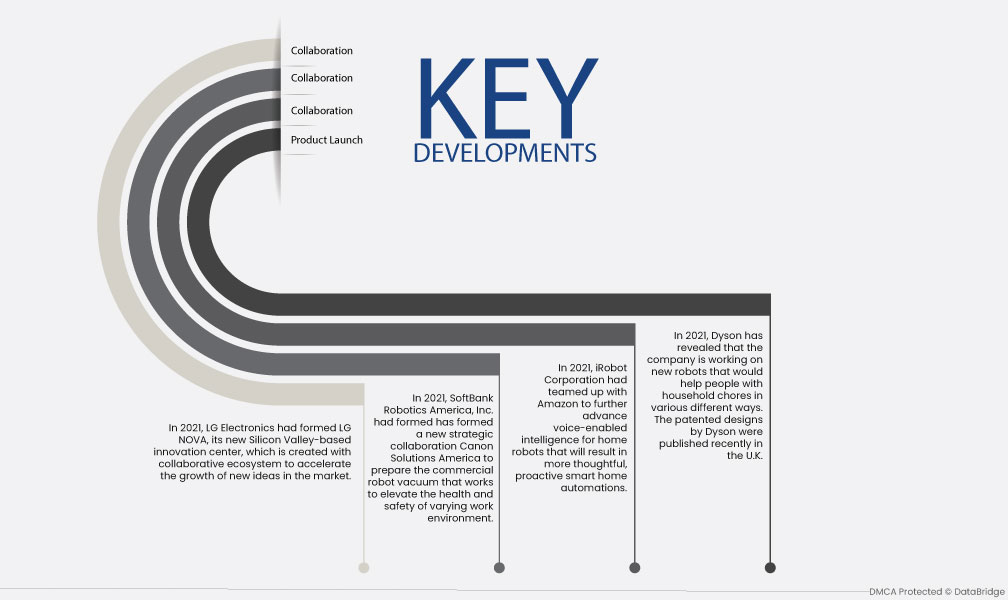The global cleaning robot market is experiencing rapid growth driven by increasing demand for automated cleaning solutions. These robots utilize advanced technologies such as artificial intelligence, sensors, and navigation systems to autonomously perform cleaning tasks in homes, offices, and other environments. The market is driven by factors such as the need for convenience, rising awareness of hygiene, labor shortages, and advancements in robotics. Integration with smart home systems and IoT platforms further enhances their functionality and usability. With continuous product innovation and a competitive landscape, the global cleaning robot market is expected to expand as consumers seek efficient and time-saving cleaning solutions.
Access Full Report @ https://www.databridgemarketresearch.com/reports/global-cleaning-robot-market
Data Bridge Market Research analyses that the Cleaning Robot Market is growing with a CAGR of 23.9% in the forecast period of 2022 to 2029 and is expected to reach USD 38,142.05 million by 2029. With the growing need for efficiency and convenience, consumers are seeking automated solutions for household chores. Cleaning robots offer a time-saving and effortless approach to cleaning tasks, reducing manual labor and freeing up time for other activities.
Key Findings of the Study
Integration with smart home systems is expected to drive the market's growth rate
The integration of cleaning robots with smart home systems and IoT platforms enables users to have greater control and convenience in managing their cleaning tasks. Through remote control and monitoring capabilities, users can easily command their cleaning robots from anywhere, schedule cleaning routines based on their preferences, and seamlessly integrate the robots into their existing smart home ecosystems. This integration enhances the overall functionality and usability of cleaning robots, providing a hassle-free and efficient cleaning experience for users.
Report Scope and Market Segmentation
|
Report Metric
|
Details
|
|
Forecast Period
|
2022-2029
|
|
Base Year
|
2021
|
|
Historic Years
|
2020 (Customizable to 2014-2019)
|
|
Quantitative Units
|
Revenue in USD Million, Volumes in Units, Pricing in USD
|
|
Segments Covered
|
Product Type (Lawn Cleaning Robots, Floor Cleaning Robots, Pool Cleaning Robots, Window Cleaning Robots, Others), Offering (Hardware, Software, Services), Components (Brushes, Chassis, Sensors and Electronic Circuit, Motor and Controllers, Battery System, Others), Utility Type (Personal Cleaning Robots, Professional Cleaning Robots), End-User (Residential, Commercial, Industrial)
|
|
Countries Covered
|
U.S., Canada and Mexico in North America, Germany, France, U.K., Netherlands, Switzerland, Belgium, Russia, Italy, Spain, Turkey, Rest of Europe in Europe, China, Japan, India, South Korea, Singapore, Malaysia, Australia, Thailand, Indonesia, Philippines, Rest of Asia-Pacific (APAC) in the Asia-Pacific (APAC), Saudi Arabia, U.A.E, South Africa, Egypt, Israel, Rest of Middle East and Africa (MEA) as a part of Middle East and Africa (MEA), Brazil, Argentina and Rest of South America as part of South America.
|
|
Market Players Covered
|
Maytronics (Israel), SoftBank Robotics America, Inc. (U.S.), Gaussian Robotics (China), iRobot Corporation (U.S.), Dyson (U.K.), Pentair (U.S.), LG Electronics (South Korea), Zodiac Pool Systems LLC (U.S.), SAMSUNG (South Korea), ILIFE (China), HOBOT (Taiwan), ECOVACS (China), Hayward Industries, Inc. (U.S.), BISSELL Inc. (U.S.), Amano Corporation (Japan), MATSUTEK Co., LTD (Taiwan), Miele & Cie. KG (Germany), Neato Robotics, Inc. (U.S.), Roborock (China), Xiaomi Inc. (China), Milagrow Business & Knowledge Solutions (Pvt.) Limited (India), Makita Corporation (Japan), among others
|
|
Data Points Covered in the Report
|
In addition to the insights on market scenarios such as market value, growth rate, segmentation, geographical coverage, and major players, the market reports curated by the Data Bridge Market Research also include in-depth expert analysis, geographically represented company-wise production and capacity, network layouts of distributors and partners, detailed and updated price trend analysis and deficit analysis of supply chain and demand.
|
Segment Analysis:
The cleaning robot market is segmented on the basis of product type, components, utility type, offering, and end-user.
- On the basis of product type, the global cleaning robot market is segmented into lawn cleaning robots, floor cleaning robots, pool cleaning robots, window cleaning robots, and others. In 2022, the floor cleaning robots segment is expected to dominate the global cleaning robot market with a CAGR of 25.0% in the forecast period of 2022 to 2029 due to greater usage of cleaning including clear floors in residential as well as commercial
In 2022, the floor cleaning robots segment is expected to dominate the product type segment of the global cleaning robot market
In 2022, floor cleaning robots segment is expected to dominate the global cleaning robot market owing to the increased use of cleaning robots to clean floors and other areas in residential and commercial spaces with a CAGR of 25.0% in the forecast period of 2022 to 2029
- On the basis of offering, the global cleaning robot market is segmented into hardware, software, and services. In 2022, the hardware segment is expected to dominate the global cleaning robot market with a CAGR of 23.6% in the forecast period of 2022 to 2029 due to the main part of any cleaning robot, which is additionally fitted with a variety of vacuuming technology to aid users in efficiently carrying out the cleaning process.
- On the basis of components, the global cleaning robot market is segmented into motors and controllers, battery system, sensors and electronic circuit, wheels, brushes, chassis, and others. In 2022, the motors and controllers segment is expected to dominate the global cleaning robot market with a CAGR of 24.9% in the forecast period of 2022 to 2029 due to the essential component of any cleaning robot and aids in giving other parts, like wheels, motion.
- On the basis of utility type, the global cleaning robot is segmented into personal cleaning robot and professional cleaning robot. In 2022, the personal cleaning robots segment is expected to dominate the global cleaning robot market with a CAGR of 22.9% in the forecast period of 2022 to 2029 due to the increasing use of robotic vacuum cleaners, the growing popularity of smart homes, changing lifestyles, and busy schedules, consumers are now searching for practical cleaning and mopping techniques.
In 2022, the personal cleaning robots segment is expected to dominate the utility type segment of the global cleaning robot market
In 2022, the personal cleaning robots segment is expected to dominate the global cleaning robot owing to the smart homes that are becoming more and more popular and products like robotic vacuum cleaners being used more frequently, consumers are looking for more convenient ways to clean and mop with a CAGR of 22.9% in the forecast period of 2022 to 2029
- On the basis of end-user, the global cleaning robot market is segmented into residential, commercial, and industrial. In 2022, the residential segment is expected to dominate the global cleaning robot market with a CAGR of 23.4% in the forecast period of 2022 to 2029 due to the application of cleaning robots being much higher across residential spaces.
Major Players
Data Bridge Market Research recognizes the following companies as the major cleaning robot market players in cleaning robot market are Maytronics (Israel), SoftBank Robotics America, Inc. (U.S.), Gaussian Robotics (China), iRobot Corporation (U.S.), Dyson (U.K.), Pentair (U.S.), LG Electronics (South Korea), Zodiac Pool Systems LLC (U.S.), SAMSUNG (South Korea), ILIFE (China)
Market Development
- In 2021, LG Electronics had formed LG NOVA, its new Silicon Valley-based innovation center, which is created with collaborative ecosystem to accelerate the growth of new ideas in the market.
- In 2021, SoftBank Robotics America, Inc. had formed has formed a new strategic collaboration Canon Solutions America to prepare the commercial robot vacuum that works to elevate the health and safety of varying work environment.
- In 2021, iRobot Corporation had teamed up with Amazon to further advance voice-enabled intelligence for home robots that will result in more thoughtful, proactive smart home automations.
- In 2021, Dyson has revealed that the company is working on new robots that would help people with household chores in various different ways. The patented designs by Dyson were published recently in the U.K.
Regional Analysis
Geographically, the countries covered in the cleaning robot market report are U.S., Canada and Mexico in North America, Germany, France, U.K., Netherlands, Switzerland, Belgium, Russia, Italy, Spain, Turkey, Rest of Europe in Europe, China, Japan, India, South Korea, Singapore, Malaysia, Australia, Thailand, Indonesia, Philippines, Rest of Asia-Pacific (APAC) in the Asia-Pacific (APAC), Saudi Arabia, U.A.E, South Africa, Egypt, Israel, Rest of Middle East and Africa (MEA) as a part of Middle East and Africa (MEA), Brazil, Argentina and Rest of South America as part of South America.
As per Data Bridge Market Research analysis:
North America is the dominant region in the cleaning robot market during the forecast period 2022 - 2029
The U.S. has established its dominance in the North American cleaning robot market due to several factors. Firstly, the country's high adoption of advanced technology creates a favorable environment for the acceptance and integration of cleaning robots into households. Additionally, the relatively high economic status of people in the U.S. enables a larger portion of the population to afford cleaning robots, resulting in widespread adoption and market growth in many homes across the region.
Asia-Pacific is estimated to be the fastest-growing region in the cleaning robot market for the forecast period 2022 - 2029
China has emerged as the dominant force in the Asia-Pacific cleaning robot market due to several reasons. The country's robust manufacturing capabilities and extensive product development efforts have resulted in a wide range of cleaning robots tailored for disinfection and cleaning applications. Additionally, China's efficient distribution networks and market penetration strategies have ensured widespread availability and adoption of cleaning robots in the region, contributing to its market dominance in the Asia Pacific region.
For more detailed information about the cleaning robot market report, click here – https://www.databridgemarketresearch.com/reports/global-cleaning-robot-market












